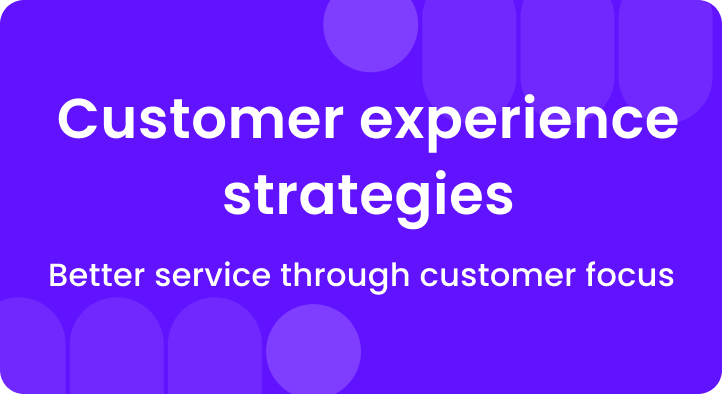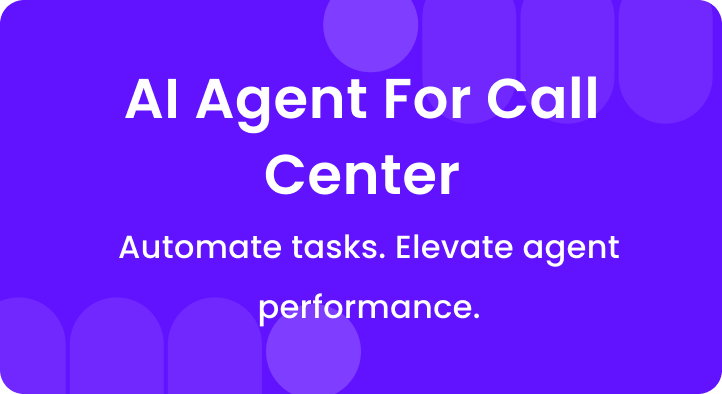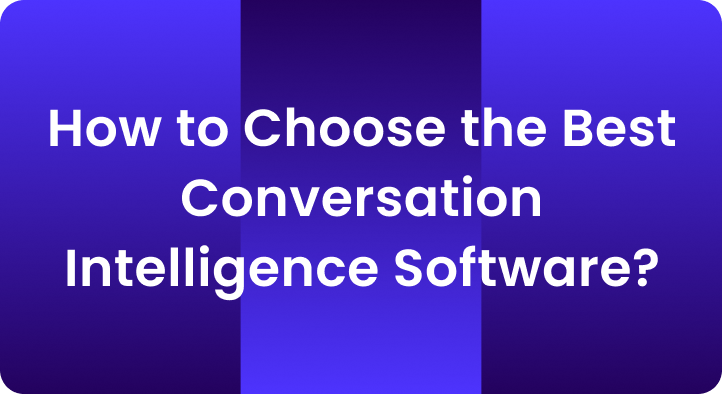Customer expectations have reached an all-time high in today’s digital-first world.
Your business success depends on delivering seamless experiences that exceed these expectations at every interaction point.
A customer experience strategy becomes your roadmap to success. It transforms random touchpoints into meaningful moments that build lasting relationships.
Customer experience represents the complete perception customers form about your brand. It encompasses every interaction from first awareness to post-purchase support.
Companies with superior CX achieve up to 3.5 times more revenue growth compared to competitors.
Modern buyers expect instant responses, personalized interactions, and effortless solutions. Research shows 90% of consumers expect immediate responses to service inquiries.
When businesses fail to meet these expectations, 73% of customers will switch to a competitor after multiple bad experiences.
In this guide, we’ll walk you through a step-by-step framework, based on real research and our own practice at Enthu for creating a CX strategy that scales, evolves, and wins.
A. What is a customer experience strategy?
A customer experience strategy is a plan to align your business goals with the lived experience of your customers. It maps how you want customers to feel, what you want them to achieve, and how you will operationalize that across touchpoints, teams, tools, and metrics.
A good CX strategy includes:
- A vision that the whole company buys into
- Realistic customer personas (and empathy maps)
- A clear gap analysis and prioritized improvements
- A roadmap of projects and milestones
- Defined owners and workflows
- KPIs and measurement systems
Modern CX strategies capture both online and offline experiences. They describe customer pain points throughout the journey and outline specific solutions to address each challenge. The strategy must be realistic, measurable, and aligned with both short-term and long-term business objectives.
B. Why CX matters for modern Businesses?
You get measurable returns from CX. Companies that focus on CX often see higher revenue and profit. A number of industry studies show major gains when organizations act intentionally on CX.
For example, companies investing in CX report higher revenues and profits compared to peers.
Customers also say they’ll pay more for better experiences. Convenience and a human touch matter.
PwC reports many customers pay extra for convenience and great service. That makes CX a direct lever for pricing power.
Operationally, CX reduces cost. You lower repeat contacts, reduce escalations, and improve first contact resolution.
Automation and AI increase efficiency while keeping quality high. Gartner projects that automation rates and AI adoption will rise significantly in contact centers.
Finally, CX breaks down silos. A customer-centric approach forces product, marketing, sales, and support to align. That improves speed and reduces friction for customers.
C. What makes a good customer experience?
A good CX feels simple, personal, and fast. It balances automation with human care. It anticipates problems and fixes them before they escalate.
Common traits of great CX:
- Omnichannel consistency: Data flows across chat, phone, email, and app.
- Fast resolution: Customers get answers quickly. First contact matters.
- Personalization at scale: You use data to tailor messages and offers.
- Human-in-the-loop: Agents step in for complex or emotional cases.
- Proactive care: You surface updates before customers ask.
- Feedback loop: You collect feedback and act on it.
Customers hate repeating themselves. They dislike bots that don’t help. They leave when service feels generic. Fix those first.
D. Top 10 practical tips to build a customer experience strategy
Building an effective CX strategy requires systematic planning and execution across multiple organizational levels. These practical steps provide a roadmap for transforming customer interactions into competitive advantages.
1. Conduct deep customer research and build empathy
Understanding your audience forms the foundation of effective CX strategy development. This process goes beyond basic demographics to uncover emotional drivers, hidden motivations, and unspoken frustrations that influence customer behavior.
Start by analyzing your most valuable customers:
- What industries do they work in?
- What are their job titles or income levels?
- Which products or services do they gravitate toward?
- What shared traits do they possess?
Deploy multiple research methodologies, including surveys, interviews, focus groups, and behavioral analytics, to capture comprehensive customer insights. Create detailed personas representing key customer segments with specific needs, motivations, and preferences.
Pro tip: Use empathy mapping exercises to help teams understand customer emotions, thoughts, and experiences throughout their journeys. This emotional understanding enables more relevant and resonant experience design.
2. Map complete customer journeys and touchpoint goals
Creating comprehensive customer journey maps identifies every interaction opportunity where customers engage with your brand. This process involves determining the purpose of every single interaction and understanding how each touchpoint contributes to overall experience quality.
Essential touchpoints to identify include:
- Digital touchpoints: Website, social media, email campaigns, mobile apps, and online advertisements
- Physical touchpoints: Store visits, direct mail, printed materials, and in-person events
- Support touchpoints: Phone calls, live chat, help desk tickets, and self-service portals
The 5 A’s framework helps structure customer journey mapping:
- Aware: How do customers discover your brand? This might happen through search ads, referrals, social media, or organic research. This first impression sets expectations for the entire relationship.
- Appeal: Prospects interested in learning more engage with your content, compare offerings, and evaluate whether your solution fits their needs.
- Ask: Customers actively seek detailed information through reviews, demos, consultations, or speaking with sales representatives.
- Act: The purchase decision and transaction process, including payment, onboarding, and initial product setup.
- Advocate: Post-purchase evaluation determines whether customers become loyal advocates who share positive experiences and generate referrals.
Mark critical moments of truth that truly determine customer loyalty. An initial Google ad may capture attention, but the personalized support customers receive after their first issue often matters more for long-term relationships.
3. Design future state visions with root cause analysis
Transform journey insights into compelling future state visions that guide organizational efforts. This step requires understanding why current experiences fall short of expectations rather than just addressing symptoms.
Apply the “5 Whys” technique systematically:
- Why are customers abandoning shopping carts? : Because the checkout process is confusing
- Why is the checkout process confusing?: Because there are too many required fields
- Why are there too many required fields?: Because different departments require different information
- Why do departments need different information?: Because systems aren’t integrated
- Why aren’t systems integrated?: Because we haven’t prioritized cross-departmental alignment
This analysis often reveals that surface-level problems like “high cart abandonment” actually stem from organizational or technical issues that require systemic solutions rather than quick fixes.
4. Select and implement appropriate technology solutions
Technology platforms enable scalable experience delivery across multiple channels and customer segments. The key is choosing solutions that integrate seamlessly rather than creating additional silos.
Core technology categories to evaluate:
- Customer Relationship Management (CRM): Centralized customer data and interaction history across all touchpoints
- Marketing automation: Triggered communications based on customer behavior and preferences
- Customer service platforms: Omnichannel support with ticket routing and escalation workflows
- Analytics and insights: Real-time dashboards and predictive modeling capabilities
- AI-powered solutions: Chatbots, sentiment analysis, and personalization engines
At Enthu.A, we offer specialized solutions for call center quality assurance with automated sentiment analysis capabilities. Consider taking advantage of free evaluation offers to assess current capabilities before major technology investments.
Integration checklist:
- Can systems share customer data in real-time?
- Do platforms provide unified reporting and analytics?
- Will new technology fit existing workflows?
- How will you train teams on new capabilities?
5. Establish comprehensive measurement frameworks
Define success metrics that align with business objectives and customer outcomes. Without proper measurement, you cannot assess initiative effectiveness or optimize future investments.
Essential customer satisfaction metrics:
- Customer Satisfaction Score (CSAT): Immediate reaction to specific interactions – deploy strategically after key touchpoints
- Net Promoter Score (NPS): Long-term loyalty and advocacy potential through recommendation likelihood questions
- Customer Effort Score (CES): How much work customers invest in achieving objectives – lower scores indicate better experiences
Operational performance indicators:
- First Contact Resolution Rate
- Average Response Time by Channel
- Customer Retention Rate by Segment
- Employee Satisfaction Scores
Business impact measurements:
- Customer Lifetime Value (CLV)
- Revenue per Customer
- Customer Acquisition Cost through Referrals
Track leading indicators like satisfaction scores alongside lagging indicators like revenue and retention. Create dashboards that provide real-time visibility into CX performance across all touchpoints.
6. Build cross-functional customer-centric teams
Develop organizational capabilities that support excellent customer experiences across all departments. Remember that every employee influences customer perception, regardless of whether they interact directly with customers.
Essential training components:
- Communication skills: Empathy, active listening, clear explanation of complex concepts
- Product knowledge: Deep understanding of features, benefits, and common use cases
- Problem-solving: Root cause analysis and creative solution development
- Emotional intelligence: Recognizing and responding appropriately to customer emotions
Team empowerment strategies:
- Provide clear service standards with decision-making authority
- Enable quick issue resolution without excessive approval processes
- Create feedback loops between frontline teams and management
- Recognize and reward exceptional customer service examples
Cross-functional collaboration ensures consistent experiences across departments. Marketing, sales, support, and product teams must align around shared customer objectives rather than departmental goals.
7. Implement systematic feedback collection and response
Create processes for collecting, analyzing, and acting on customer feedback across multiple channels. Effective feedback systems provide early warning signs about experience problems while identifying optimization opportunities.
Multi-channel feedback collection:
- Post-interaction surveys: Immediate feedback after support calls, purchases, or service interactions
- Periodic relationship surveys: Quarterly or annual assessments of overall satisfaction
- Social media monitoring: Real-time sentiment tracking across platforms
- Review platform analysis: Systematic evaluation of third-party review sites
- Direct customer interviews: In-depth conversations about experience quality
Advanced analytics applications:
- Sentiment analysis using natural language processing
- Text analytics to identify common themes and issues
- Predictive modeling to forecast satisfaction trends
- Journey analytics examines behavior patterns across touchpoints
Response framework:
- Acknowledge feedback within 24 hours
- Investigate root causes systematically
- Implement corrections where possible
- Communicate improvements back to customers
- Track resolution effectiveness over time
Close feedback loops by demonstrating how customer input drives business changes. This approach builds trust and encourages continued engagement.
8. Focus optimization efforts on high-impact touchpoints
Prioritize initial improvement efforts on interactions with the greatest influence on customer satisfaction and business outcomes. Resource constraints require strategic focus rather than attempting to improve everything simultaneously.
Identify high-impact moments:
- First impressions: Initial brand interactions through advertising, website visits, or referrals
- Purchase processes: Shopping cart, checkout, payment, and confirmation experiences
- Onboarding sequences: Initial product setup, training, and early usage support
- Problem resolution: How quickly and effectively you address customer issues
- Renewal decisions: Factors influencing subscription renewals or repeat purchases
Impact assessment criteria:
- How many customers experience this touchpoint?
- What emotions do customers typically feel at this moment?
- How much does this interaction influence loyalty and retention?
- What’s the cost of improvement versus potential business impact?
Start with quick wins that demonstrate improvement momentum while building capabilities for more complex optimization projects.
9. Enable personalization at scale through technology
Develop capabilities that deliver relevant, individualized experiences without overwhelming operational resources. Modern personalization balances efficiency with authenticity to maintain human connection.
Personalization maturity progression:
- Basic Level: Use customer names, purchase history, and demographic information in communications
- Intermediate Level: Behavioral triggers and dynamic content based on interaction patterns
- Advanced Level: Machine learning recommendations and predictive personalization
- Expert Level: Real-time optimization across all touchpoints with continuous learning
Implementation strategies:
- Segmentation: Group customers by behavior, preferences, and value
- Triggered Messaging: Automated responses based on specific actions
- Dynamic Content: Website and email content that adapts to individual visitors
- Recommendation Engines: Suggest relevant products or content based on usage patterns
Companies like Netflix and Spotify demonstrate effective large-scale personalization through sophisticated algorithms that learn from user behavior. Start with basic segmentation and gradually increase sophistication based on results and capabilities.
10. Foster continuous innovation and adaptation
Establish processes for regularly evaluating and improving customer experiences as markets, technology, and customer expectations evolve. Innovation should focus on solving real customer problems rather than implementing technology for its own sake.
Innovation framework:
- Monitor trends: Industry developments, competitor activities, and emerging technologies
- Encourage experimentation: Employee suggestions and customer co-creation opportunities
- Test systematically: Pilot programs before full deployment
- Learn continuously: Analyze both successful experiments and failures
- Scale successful innovations: Implement proven improvements across the organization
Areas for ongoing innovation:
- Channel optimization: New communication methods and interaction opportunities
- Process improvement: Streamlined workflows and reduced friction points
- Technology integration: AI, automation, and predictive analytics applications
- Service expansion: Additional value-added services that enhance customer success
Regular strategy reviews and performance assessments identify necessary adjustments. Encourage organizational cultures that embrace change and view customer feedback as innovation opportunities rather than criticism.
E. Tips to measure success in CX
Here are some KPIs you should always prioritize to measure CX success include:
1. Essential KPIs for CX success
- Customer Satisfaction Score (CSAT): Gives near-instant feedback on how happy a customer was with a specific interaction or touchpoint.
- Net Promoter Score (NPS): Gauges long-term loyalty by asking how likely a customer is to recommend you to others.
- Customer Effort Score (CES): Measures how easy or hard it was for a customer to resolve an issue – lower effort means higher loyalty.
- Customer Health Score: A composite metric combining usage, engagement, support history, and financial indicators to predict renewal or expansion risk.
- Customer Lifetime Value (CLV): Estimates the total net profit a customer brings over their entire relationship with you.
2. Operational metrics that matter
- Average Time to Resolution: Tracks how long it takes, on average, to fully resolve a customer’s issue from first contact to closure.
- Cart Abandonment Rate: The percentage of shoppers who add items to cart but never complete purchase; signals friction in checkout.
- Employee Satisfaction: Shows how content your internal teams are – happier employees often deliver better customer service.
- Visitor Intent: Measures why people visit your site (e.g. research, purchase) to align website design and messaging with real needs.
3. Advanced analytics and insights
- Sentiment Analysis: Applies AI to detect emotion (positive, negative, neutral) in customer feedback and conversations.
- Customer Loyalty Tracking: Monitors how often customers buy again vs. switch, signaling relationship strength.
- AI for Call Center QA: Uses automated evaluation to assess interaction quality, uncover coaching opportunities, and maintain consistency.
Conclusion
Customer experience excellence requires more than good intentions.
It demands intelligent infrastructure that identifies issues before they escalate and transforms every interaction into an opportunity for relationship building.
That’s where technology meets strategy.
Enthu.AI’s conversation intelligence platform is purpose-built for contact centers seeking to elevate customer experience through AI-powered quality assurance.
Our sentiment analysis technology automatically evaluates every customer interaction, providing real-time insights into satisfaction levels, agent performance, and service quality patterns.
Instead of reviewing random samples, you gain comprehensive visibility into your entire customer experience landscape.
With automated scoring, coaching recommendations, and predictive analytics, Enthu.AI enables contact centers to maintain consistent service excellence while scaling operations efficiently.
Ready to transform your customer experience strategy?
Start with 5 free evaluations and discover how Enthu.AI helps industry leaders turn every conversation into a competitive advantage.
FAQs
1. How long does it take to see results from a customer experience strategy?
Most companies observe initial improvements within 3-6 months of implementation, with significant ROI typically visible within 12-18 months. Early wins often include reduced support tickets and improved satisfaction scores, while longer-term benefits include increased customer lifetime value and reduced churn rates.
2. What's the difference between customer service and customer experience strategy?
Customer service focuses on resolving individual issues reactively, while customer experience strategy encompasses the entire customer journey proactively. CX strategy includes marketing touchpoints, sales processes, product design, and post-purchase relationships, creating comprehensive experiences rather than isolated interactions.
3. How much should companies invest in customer experience initiatives?
Research shows companies with superior CX achieve 300% ROI on their investments. Industry leaders typically allocate 15-20% of their revenue to CX-related initiatives, though the exact amount depends on business size, industry, and current satisfaction levels. Start with high-impact, low-cost improvements before scaling investments.



 On this page
On this page

